 W
WThe African bullfrog is a species of frog in the family Pyxicephalidae. It is also known as the pixie frog due to its scientific name. It is found in Angola, Botswana, Kenya, Malawi, Mozambique, Namibia, South Africa, Swaziland, Tanzania, Zambia, Zimbabwe, and possibly the Democratic Republic of the Congo. It has long been confused with the edible bullfrog and species boundaries between them, including exact range limits, are not fully understood. Additionally, P. angusticeps of coastal East Africa only was revalidated as a separate species in 2013.
 W
WAmbystoma talpoideum, the mole salamander, is a species of salamander found in much of the eastern and central United States, from Florida to Texas, north to Illinois, east to Kentucky, with isolated populations in Virginia and Indiana. Older sources often refer to this species as the tadpole salamander because some individuals remain in a neotenic state. This salamander lives among the leaf litter on the forest floor, migrating to ponds to breed.
 W
WThe Apennine yellow-bellied toad is a species of toad in the family Bombinatoridae endemic to Italy. Its natural habitats are temperate forests, temperate grassland, swamps, freshwater marshes, intermittent freshwater marshes, arable land, pastureland, ponds, open excavations, irrigated land, and seasonally flooded agricultural land. It is threatened by habitat loss.
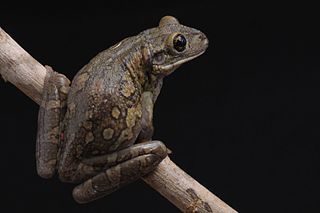 W
WThe black-spotted casque-headed tree frog is a species of frog in the family Hylidae endemic to Brazil. Its natural habitats are subtropical or tropical moist lowland forests, subtropical or tropical moist shrubland, freshwater lakes, intermittent freshwater lakes, freshwater marshes, intermittent freshwater marshes, rural gardens, and heavily degraded former forests. It is threatened by habitat loss.
 W
WThe black-spotted sticky frog is a small frog with a black spot just in front of each of its hind legs. It releases a sticky substance when threatened, thereby making it an unpleasant meal for predators, allowing it to escape from harm.
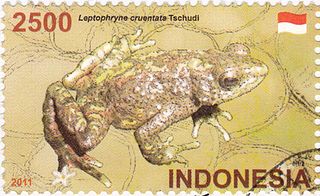 W
WThe bleeding toad, fire toad, or Indonesia tree toad is a species of "true toad", family Bufonidae, endemic to Java, Indonesia. Leptophryne javanica was included in this species prior its description as a distinct species in 2018, although the degree of differentiation between these species is low. Bleeding toad is listed as a critically endangered species due to a drastic population decline. The reasons of this decline are unclear, but the decline is consistent with chytridiomycosis, despite ambiguous identification.
 W
WBoophis goudotii is a species of frog in the family Mantellidae. It is endemic to Madagascar where it is widespread on the high plateau of central Madagascar. Records elsewhere are uncertain and many of them represent misidentifications. It is the only Malagasy frog where females are known to be vocal.
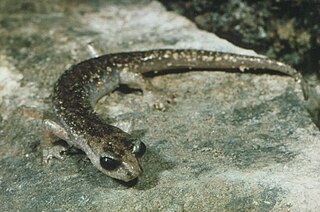 W
WThe brown cave salamander, also known as Gene's cave salamander, Sardinian cave salamander, or simply Sardinian salamander, is a species of salamander in the family Plethodontidae. It is endemic to Sardinia (Italy). Its natural habitats are temperate forests, rocky areas, caves, and subterranean habitats. It is threatened by habitat loss.
 W
WThe Corsican brook salamander or Corsican mountain newt is a species of salamander in the family Salamandridae. It is endemic to Corsica, an island in the Mediterranean Sea.
 W
WThe Corsican fire salamander is a species of salamander in the family Salamandridae found only on the island of Corsica as an endemic species. In former times, this species was known as a subspecies of the widespread but continental-distributed fire salamander, which may appear quite similar.
 W
WDelalande's sand frog, also known as Delalande's frog, Cape sand frog, or striped pixie, is a species of frog in the family Pyxicephalidae. It is endemic to western and southern South Africa and occurs in the low-lying areas of Namaqualand, Western Cape, and Eastern Cape as far east as Cape St. Francis.
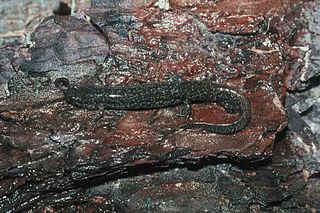 W
WThe southern dusky salamander is a species of salamander native to the coastal regions of the southeastern United States, from Virginia to Texas. Older sources often refer to it as the eared triton.
 W
WElachistocleis bicolor is a species of frog in the family Microhylidae. It is found in central Argentina and northward through Paraguay and Uruguay to Amazonian Brazil; earlier reports from Bolivia probably refer to Elachistocleis haroi.
 W
WEleutherodactylus martinicensis is a species of frog in the family Eleutherodactylidae found in Antigua and Barbuda, Dominica, Guadeloupe, Martinique, and Saint Lucia. Its natural habitats are subtropical or tropical dry forests, subtropical or tropical moist lowland forests, subtropical or tropical moist montane forests, subtropical or tropical moist shrubland, subtropical or tropical seasonally wet or flooded lowland grassland, arable land, pastureland, plantations, rural gardens, urban areas, and heavily degraded former forests. It is threatened by habitat loss.
 W
WThe four-toed salamander is a lungless salamander native to eastern North America. It is the only species of the monotypic genus Hemidactylium.
 W
WFreycinet's frog also commonly known as the wallum rocket frog, inhabits coastal areas from Fraser Island, Queensland, south to the Jervis Bay Territory of New South Wales.
 W
WThe fungoid frog or Malabar Hills frog is a colourful frog found on the forest floor and lower vegetation in the Western Ghats in south-western India from Bombay to Kerala. It is very similar to another species with which it overlaps partly in range, Hydrophylax bahuvistara which extends further into parts of central India. Although restricted in range within peninsular India, they are of least conservation concern. Their upper parts vary in colour from brownish-red to bright crimson.
 W
WThe Hispaniolan common tree frog, or Dominican tree frog, is a species of frog in the family Hylidae endemic to the island of Hispaniola. It is found in the Dominican Republic and Haiti.
 W
WHynobius nebulosus, the Mitsjama salamander, is a species of salamander in the family Hynobiidae endemic to Japan. Its natural habitats are temperate forests, rivers, swamps, freshwater springs, and irrigated land. It is threatened by habitat loss.
 W
WThe Japanese common toad, Japanese warty toad or Japanese toad is a species of toad in the family Bufonidae. It is endemic to Japan. Its natural habitats are subarctic forests, temperate forests, temperate shrubland, swamps, freshwater marshes, intermittent freshwater marshes, freshwater springs, arable land, rural gardens, urban areas, ponds, and irrigated land.
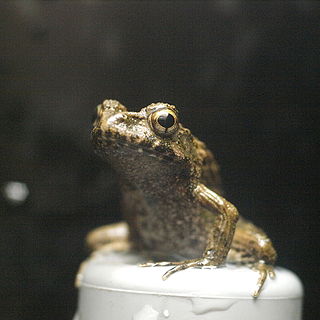 W
WThe Japanese wrinkled frog is a species of true frog native to Japan and introduced to Hawaii in the late 19th century. It has sometimes been regarded as a single species with the Imienpo Station frog which is found on the East Asian mainland. The two species are distinguished from others by their rough and uneven skin. It lives and breeds in various freshwater environments, including ponds, streams and wetlands. The IUCN does not consider this species to be faced by any significant threats.
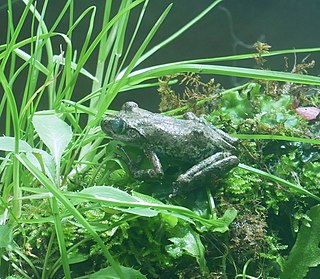 W
WThe Kajika frog or Buerger's frog is a species of frog in the family Rhacophoridae. It is endemic to Japan where it can be found on Honshu, Kyushu, and Shikoku islands. It is locally threatened by habitat loss caused by dam building and construction of concrete riverbanks.
 W
WKuhl's creek frog or large-headed frog is a species of frog in the family Dicroglossidae.
 W
WLeptobrachium hasseltii is a species of toad found in Southeast Asia. This frog named after Dutch Naturalist Johan Conrad van Hasselt. According to the current understanding, this species is known with certainty only from Java, Madura, Bali, and Kangean Islands, Indonesia. The species is also commonly reported to occur in the Philippines, but these are believed to refer to another, unnamed species.
 W
WMicrohyla achatina is a species of narrow-mouthed frog endemic to Java, Indonesia.
 W
WPeltophryne peltocephala is a species of toad in the family Bufonidae. It is endemic to Cuba and found in central and eastern Cuba as well as on some outlying islands. It occurs in a range of habitats including broadleaf forest, grassland, savanna, and agricultural areas. It is a common species but locally threatened by habitat loss.
 W
WPeron's tree frog, also known as the emerald-spotted tree frog, emerald-speckled tree frog, laughing tree frog, and maniacal cackle frog, is a common Australian tree frog of the family Pelodryadidae.
 W
WPseudobufo is a monotypic genus of toads in the family Bufonidae. It is represented by a single species, Pseudobufo subasper. It is found in Indonesia and Malaysia. Its natural habitats are subtropical or tropical swamps and swamps. It is threatened by habitat loss. This toad can only be found in peat swamps. They have fully webbed hind feet and are closely associated with water.
 W
WThe quacking frog also known as the red-thighed froglet is a species of frog in the family Myobatrachidae. It is endemic to Australia.
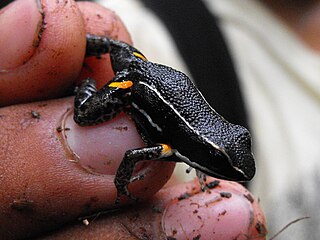 W
WThe spot-legged poison frog is a species of dendrobatid frog found in Bolivia, Brazil, Peru, and Venezuela. Its habitat includes tropical and subtropical moist broadleaf forests, especially freshwater swamp forests.
 W
WThe spring peeper is a small chorus frog widespread throughout the eastern United States and Canada. They are so called because of their chirping call that marks the beginning of spring. There are two subspecies:The northern, P. c. crucifer, found all over the eastern United States and eastern Canada. The southern, P. c. bartramiana. The southern is distinguished by a strong dark marking on its belly. P. c. bartramiana is found along the southern Gulf Coast from southeastern Texas to northern Florida and southern Georgia.
 W
WTheloderma leporosum is a species of frog in the family Rhacophoridae. It is found in Peninsular Malaysia and Sumatra (Indonesia).
 W
WThe three-lined salamander is a species of salamander in the family Plethodontidae. It is endemic to the south-eastern United States.
 W
WThe western chorus frog, also known as striped chorus frog, or midland chorus frog is a species of frog found in Canada and the United States.